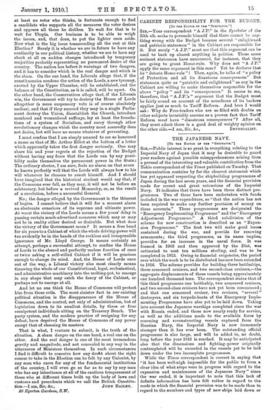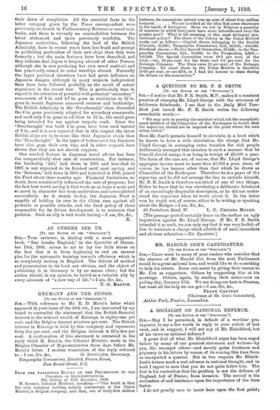THE JAPANESE NAVY.
[To VIZ EDITOR OP TEl "..SPECTATOR."]
Sin,—Public interest is so great in everything relating to the Imperial Navy of Japan that it may be desirable to guard your readers against possible misapprehensions arising from a perusal of the interesting and valuable contribution from the Tokio correspondent of the Times published on Tuesday. That communication contains by far the clearest statement which has yet appeared respecting the shipbuilding programmes of Japan during the last seven years, and the financial provision made for recent and great extensions of the Imperial Navy. It indicates that there have been three distinct pro- grammes. Two of these have been undertaken with funds included in the war expenditure, so "that the nation has not been required to make any further provision of money on these accounts." These programmes are designated the "Emergency Implementing Programme" and the "Emergency Adjustment Programme." A third subdivision of the scheme for new construction is described as an "Expan- sion Programme." The first two will make good losses sustained during the war, and provide for renewing armaments ; the third programme, as its name implies, provides for an increase in the naval force. It was framed in 1903 and then approved by the Diet, was estimated to rest ten millions sterling, and was to be completed in 1913. Owing to financial exigencies, the period over which the work is to be distributed has now been extended to 1916. The scheme provides for building three battleships, three armoured cruisers, and two second-class credsers,—the aggregate displacements of these vessels being approximately one hundred thousand tons. The correspondent states that of this third programme one battleship, two armoured cruisers, and two second-class cruisers have not yet been commenced ; and that one armoured cruiser, two cruisers, "several" destroyers, and six torpedo-boats of the Emergency Imple- menting Programme have also yet to be laid down. Taking into account the Japanese warships completed since the war with Russia ended, and those now nearly ready for service, as well as the additions made to the available force by rearming and reconstructing vessels captured from the Russian Navy, the Imperial Navy is now immensely stronger than it has ever been. The outstanding official programme is also large, and will be added to, no doubt, long before the year 1916 is reached. It may be anticipated also that the dimensions and fighting-power originally contemplated will be exceeded in the vessels yet to be laid down under the two incomplete programmes.
While the Times correspondent is correct in saying that "it has been well-nigh impossible for the public to form a clear idea of what steps were in progress with regard to the expansion and maintenance of the Japanese Navy" since the war ended, it is important to note that this lack of definite information has been felt rather in regard to the mode in which the financial provision was to be made than in regard to the numbers and types of new ships laid down or
their dates of completion. All the essential facts in the latter category given by the Times correspondent were previously on record in Parliamentary Returns or naval text- books, and there is virtually no contradiction between the latest statement and those previously available. The Japanese authorities, following the lead of the British Admiralty, have in recent years been less frank and prompt in publishing particulars of their new ships than they were formerly ; but the main features have been described, and they indicate that Japan is keeping abreast of other Powers, although she is now producing her own naval materiel, and has practically ceased to order warships abroad. Naturally the types produced elsewhere have had great influence on Japanese designs, although in many respects independent lines have been followed, probably as the result of actual experience in the recent war. This is particularly true in regard to the retention of powerful well-protected" secondary " armaments of 6 in. and 41 in. guns as auxiliaries to 12 in. guns in recent Japanese armoured cruisers and battleships. The British Admiralty in the 'Dreadnought' class discarded the 6 in. guns previously adopted for secondary armaments, and used only 3 in. guns in addition to 12 in., the small guns being intended for use against torpedo craft. Since the 'Dreadnought' was built 4 in. guns have been used instead of 3 in., and it is now reported that in this respect the latest British ships are to be more like their Japanese rivals than the Dreadnought.' In the types of boilers used the Japanese have also gone their own way, and in other respects have shown that they are not slavish copyists.
One marked feature in Japanese naval affairs has been the comparatively slow rate of construction. For instance, the battleship Aki,' laid down in 1905 and launched in 1907, is not expected to be finished until next spring, and the Satsuma,' laid down in 1905 and launched in 1906, joined the Fleet about three months ago. Financial limitations, no doubt, have considerably influenced the rate of progress ; but the fact best worth noting is that work on so large a scale and so novel in character has been undertaken and accomplished successfully. As it stands to-day, the Japanese Fleet is capable of holding its own in the China seas against all probable or possible attacks, and the fixed policy of those responsible for its future development is to maintain that position. Such an ally is well worth having.—I am, Sir, &c., X.















































 Previous page
Previous page